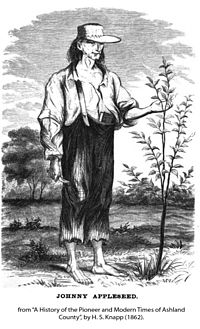Johnny Appleseed
| Johnny Appleseed | |
|---|---|

Image from Howe's Historical Collection
|
|
| Born |
John Chapman September 26, 1774 Leominster, Massachusetts, British America |
| Died | March 18, 1845 (aged 70) Fort Wayne, Indiana, U.S. |
| Nationality | American |
| Occupation | Missionary and gardener |
| Parent(s) | Nathaniel Chapman Elizabeth Simonds |
John Chapman (September 26, 1774 – March 18, 1845), often called Johnny Appleseed, was an American pioneer nurseryman who introduced apple trees to large parts of Pennsylvania, Ontario, Ohio, Indiana, and Illinois, as well as the northern counties of present-day West Virginia. He became an American legend while still alive, due to his kind, generous ways, his leadership in conservation, and the symbolic importance he attributed to apples. He was also a missionary for The New Church (Swedenborgian) and the inspiration for many museums and historical sites such as the Johnny Appleseed Museum in Urbana, Ohio, and the Johnny Appleseed Heritage Center in between Lucas, Ohio, and Mifflin, Ohio.
John Chapman was born on September 26, 1774, in Leominster, Massachusetts, the second child (after his sister Elizabeth) of Nathaniel and Elizabeth Chapman (née Simonds, married February 8, 1770) of Massachusetts. His birthplace has a granite marker, and the street is called Johnny Appleseed Lane.
While Nathaniel was in military service, his wife died (July 18, 1776) shortly after giving birth to a second son, Nathaniel. The baby died about two weeks after his mother. Nathaniel Chapman ended his military service and returned home in 1780 to Longmeadow, Massachusetts. In the summer of 1780 he married Lucy Cooley of Longmeadow, Massachusetts, and they had 10 children.
According to some accounts, an 18-year-old John persuaded his 11-year-old half-brother Nathaniel to go west with him in 1792. The duo apparently lived a nomadic life until their father brought his large family west in 1805 and met up with them in Ohio. The younger Nathaniel decided to stay and help their father farm the land.
...
Wikipedia
